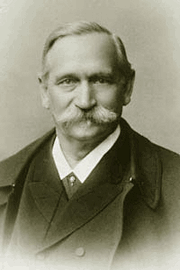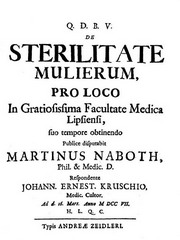This article is part of the series "A Moment in History" where we honor those who have contributed to the growth of medical knowledge in the areas of anatomy, medicine, surgery, and medical research.
Martin Naboth (1675 – 1721). Not much is known about this German physician and anatomist. He was born in 1675 in Calau, a town in Southern Brandenburg, Germany. He studied medicine at the University in Leipzig, receiving his doctorate in Philosophy in 1701 and his MD in 1703. Although his interests were based in chemistry, Naboth became an avid anatomist, with interest in the anatomy of the female reproductive system.
His main publication in 1707 was “De Sterilitate Mulierum” (On Sterility in Women). In this book he refers to small pearl-like transparent structures found in the uterine cervix. Believing that he had discovered the way women store eggs, he called these “ovarium novum” (new ovaries). His discovery was accepted by many and these structures came to be known as “Ovula Nabothii “. Only later were to understand these structures as cysts created by clogging of the opening of the glands found around the uterine cervix. These mucus-producing glands are known as the [cervical glands] and also as Nabothian glands. These cysts, which are common and do not represent a sign of cervical cancer, are known today as Nabothian cysts.
Naboth had only rediscovered these cysts first described in 1681 by Guillaume des Noues (1650 – 1735), although the eponym records Naboth’s name.
Naboth published De Organo Auditus in 1703, and was appointed Professor of Chemistry in Leipzig in 1707. He died in Leipzig on May 23, 1721 leaving a large anatomical collection. We have not been able to find an image of Naboth, so we are depicting the title page of his 1707 “De Sterilitate Mulierum”. If you click on the image you can see a larger depiction.
Sources
1. “Histoire de la Mèdecine, depuis son origine jusqu'au dix-neuvime siècle” A. J. L. Jourdan ; E. F. M. Bosquillon 1815
2. DESNOUES, G. Rariora quadam observata in genitalibus mulierum. Zodiacus Medico-GaUicus, sive Miscellaneorum Medico-Physicorum Gallicorum. Annus
Tertius, Geneva. Leonard Chouet. (Feb. 1681) 1682, pp. 20-21.
3. “The Origin of Medical Terms” Skinner HA 1970 Hafner Publishing Co.




